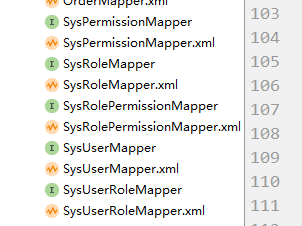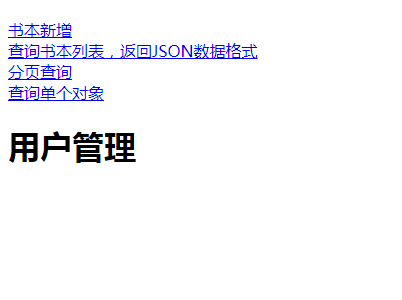Pom依赖
<dependency> 3 <groupId>org.apache.shiro</groupId> 4 <artifactId>shiro-core</artifactId> 5 <version>${shiro.version}</version> 6 </dependency> 7 8 <dependency> 9 <groupId>org.apache.shiro</groupId> 10 <artifactId>shiro-web</artifactId> 11 <version>${shiro.version}</version> 12 </dependency> 13 14 <dependency> 15 <groupId>org.apache.shiro</groupId> 16 <artifactId>shiro-spring</artifactId> 17 <version>${shiro.version}</version> 18 </dependency>
配置web.xml
<!-- shiro过滤器定义 --> 2 <filter> 3 <filter-name>shiroFilter</filter-name> 4 <filter-class>org.springframework.web.filter.DelegatingFilterProxy</filter-class> 5 <init-param> 6 <!-- 该值缺省为false,表示生命周期由SpringApplicationContext管理,设置为true则表示由ServletContainer管理 --> 7 <param-name>targetFilterLifecycle</param-name> 8 <param-value>true</param-value> 9 </init-param> 10 </filter> 11 <filter-mapping> 12 <filter-name>shiroFilter</filter-name> 13 <url-pattern>/*</url-pattern> 14 </filter-mapping>
逆向生产对应实体,mapper接口,*mapper.xml
<!--<table schema="" tableName="t_sys_role_permission" domainObjectName="SysRolePermission"--> <!--enableCountByExample="false" enableDeleteByExample="false"--> <!--enableSelectByExample="false" enableUpdateByExample="false">--> <!--<!– 忽略列,不生成bean 字段 –>--> <!--<!– <ignoreColumn column="FRED" /> –>--> <!--<!– 指定列的java数据类型 –>--> <!--<!– <columnOverride column="LONG_VARCHAR_FIELD" jdbcType="VARCHAR" /> –>--> <!--</table>--> <!--<table schema="" tableName="t_sys_user" domainObjectName="SysUser"--> <!--enableCountByExample="false" enableDeleteByExample="false"--> <!--enableSelectByExample="false" enableUpdateByExample="false">--> <!--<!– 忽略列,不生成bean 字段 –>--> <!--<!– <ignoreColumn column="FRED" /> –>--> <!--<!– 指定列的java数据类型 –>--> <!--<!– <columnOverride column="LONG_VARCHAR_FIELD" jdbcType="VARCHAR" /> –>--> <!--</table>--> <!--<table schema="" tableName="t_sys_role" domainObjectName="SysRole"--> <!--enableCountByExample="false" enableDeleteByExample="false"--> <!--enableSelectByExample="false" enableUpdateByExample="false">--> <!--<!– 忽略列,不生成bean 字段 –>--> <!--<!– <ignoreColumn column="FRED" /> –>--> <!--<!– 指定列的java数据类型 –>--> <!--<!– <columnOverride column="LONG_VARCHAR_FIELD" jdbcType="VARCHAR" /> –>--> <!--</table>--> <!--<table schema="" tableName="t_sys_user_role" domainObjectName="SysUserRole"--> <!--enableCountByExample="false" enableDeleteByExample="false"--> <!--enableSelectByExample="false" enableUpdateByExample="false">--> <!--<!– 忽略列,不生成bean 字段 –>--> <!--<!– <ignoreColumn column="FRED" /> –>--> <!--<!– 指定列的java数据类型 –>--> <!--<!– <columnOverride column="LONG_VARCHAR_FIELD" jdbcType="VARCHAR" /> –>--> <!--</table>--> <!--<table schema="" tableName="t_sys_permission" domainObjectName="SysPermission"--> <!--enableCountByExample="false" enableDeleteByExample="false"--> <!--enableSelectByExample="false" enableUpdateByExample="false">--> <!--<!– 忽略列,不生成bean 字段 –>--> <!--<!– <ignoreColumn column="FRED" /> –>--> <!--<!– 指定列的java数据类型 –>--> <!--<!– <columnOverride column="LONG_VARCHAR_FIELD" jdbcType="VARCHAR" /> –>--> <!--</table>-->


SysUserMapper
package com.hmc.mapper; 2 3 import com.hmc.model.ShiroUser; 4 import org.apache.ibatis.annotations.Param; 5 import org.springframework.stereotype.Repository; 6 7 @Repository 8 public interface SysUserMapper{ 9 int deleteByPrimaryKey(Integer userid); 10 11 int insert(SysUser record); 12 13 int insertSelective(SysUser record); 14 15 ShiroUser selectByPrimaryKey(Integer userid); 16 17 int updateByPrimaryKeySelective(SysUser record); 18 19 int updateByPrimaryKey(SysUser record); 20 21 ShiroUser queryByName(@Param("username")String username);
22
23 }
SysUserMapper.xml
<select id="queryByName" resultType="com.hmc.model.ShiroUser" parameterType="java.lang.String" > 97 select 98 <include refid="Base_Column_List" /> 99 from t_shiro_user 100 where username = #{uname} 101 </select>
ISysUserService
package com.hmc.service;
2
3 import com.hmc.model.SysUser;
4 import org.apache.ibatis.annotations.Param;
5
6 public interface ISysUserService {
7
8 ShiroUser queryByName(@Param("username")String username);
9
10 int insert(SysUser record);
11
12 }
IBookServiceImpl
@Service public class SysUserServiceImpl implements ISysUserService { @Autowired private SysUserMapper sysUserMapper; @Override public SysUser queryByName(String username) {
return sysUserMapper.userLogin(username);
}
}
public class ShiroRealm extends AuthorizingRealm{
@Autowired
private ISysUserService sysUserService;
//授权
@Override
protected AuthorizationInfo doGetAuthorizationInfo(PrincipalCollection principalCollection) {
}
//认证
@Override
protected AuthenticationInfo doGetAuthenticationInfo(AuthenticationToken token) throws AuthenticationException {
String username = token.getPrincipal().toString();
String password = token.getPrincipal().toString();
//根据用户名获取对应的用户信息
SysUser sysUser = sysUserService.userLogin(username);
// if (null==sysUser){
// throw new UnknownAccountException();
// }
//密码多次校验
System.out.println(sysUser);
SimpleAuthenticationInfo simpleAuthenticationInfo=new SimpleAuthenticationInfo(
sysUser.getUsername(),
sysUser.getPassword(),
//盐
ByteSource.Util.bytes(sysUser.getSalt()),
this.getName()
);
return simpleAuthenticationInfo;
}
}
spring-shiro.xml
<?xml version="1.0" encoding="UTF-8"?> <beans xmlns="http://www.springframework.org/schema/beans" xmlns:xsi="http://www.w3.org/2001/XMLSchema-instance" xsi:schemaLocation="http://www.springframework.org/schema/beans http://www.springframework.org/schema/beans/spring-beans.xsd"> <!--配置自定义的Realm--> <bean id="shiroRealm" class="com.zking.ssm.shiro.ShiroRealm"> <!--配置Shiro明文密码如何进行加密--> <!--注意:重要的事情说三次~~~~~~此处加密方式要与用户注册时的算法一致 --> <!--注意:重要的事情说三次~~~~~~此处加密方式要与用户注册时的算法一致 --> <!--注意:重要的事情说三次~~~~~~此处加密方式要与用户注册时的算法一致 --> <!--以下三个配置告诉shiro将如何对用户传来的明文密码进行加密--> <property name="credentialsMatcher"> <bean id="credentialsMatcher" class="org.apache.shiro.authc.credential.HashedCredentialsMatcher"> <!--指定hash算法为MD5--> <property name="hashAlgorithmName" value="md5"/> <!--指定散列次数为1024次--> <property name="hashIterations" value="1024"/> <!--true指定Hash散列值使用Hex加密存. false表明hash散列值用用Base64-encoded存储--> <property name="storedCredentialsHexEncoded" value="true"/> </bean> </property> </bean> <!--注册安全管理器--> <bean id="securityManager" class="org.apache.shiro.web.mgt.DefaultWebSecurityManager"> <property name="realm" ref="shiroRealm" /> </bean> <!--Shiro核心过滤器--> <bean id="shiroFilter" class="org.apache.shiro.spring.web.ShiroFilterFactoryBean"> <!-- Shiro的核心安全接口,这个属性是必须的 --> <property name="securityManager" ref="securityManager" /> <!-- 身份验证失败,跳转到登录页面 --> <!-- <property name="loginUrl" value="/home/index.shtml"/>--> <!-- 身份验证成功,跳转到指定页面 --> <!--<property name="successUrl" value="/index.jsp"/>--> <!-- 权限验证失败,跳转到指定页面 --> <!--<property name="unauthorizedUrl" value="/user/noauthorizeUrl"/>--> <!-- Shiro连接约束配置,即过滤链的定义 --> <!-- <property name="filterChainDefinitions"> </property>--> </bean> <!-- Shiro生命周期,保证实现了Shiro内部lifecycle函数的bean执行 --> <bean id="lifecycleBeanPostProcessor" class="org.apache.shiro.spring.LifecycleBeanPostProcessor"/> </beans>
UserController
@Controller
@RequestMapping("/user")
public class UserController {
@Autowired
private ISysUserService sysUserService;
@RequestMapping("/userLogin")
public String userLogin(SysUser sysUser, Model moodel){
String username = sysUser.getUsername();
String password = sysUser.getPassword();
//获取主体
Subject subject= SecurityUtils.getSubject();
//创建用户密码token
UsernamePasswordToken token=new UsernamePasswordToken(
username,
password
);
String meassage=null;
try{
subject.login(token);
}catch (IncorrectCredentialsException e){
e.printStackTrace();
meassage="密码错误";
}catch (UnknownAccountException e){
e.printStackTrace();
meassage="账号错误";
}catch (Exception e){
e.printStackTrace();
meassage="账号或者密码错误";
}
if(null==meassage){
return "index";
}
else{
moodel.addAttribute("message",meassage);
return "login";
}
}
//退出登录
@RequestMapping("/logout")
public String logout(){
//关键代码
Subject subject=SecurityUtils.getSubject();
subject.logout();
return "login";
}
//用户注册
@RequestMapping("/register")
public String register(SysUser sysUser){
//盐
String salt = PasswordHelper.createSalt();
//加密后的密码
String credentials = PasswordHelper.createCredentials(sysUser.getPassword(), salt);
sysUser.setPassword(credentials);
sysUser.setSalt(salt);
System.out.println(sysUser);
sysUserService.InsetSysUser(sysUser);
return "login";
}
}
盐加密的工具类
PasswordHelper
public class PasswordHelper {
/**
* 随机数生成器
*/
private static RandomNumberGenerator randomNumberGenerator = new SecureRandomNumberGenerator();
/**
* 指定hash算法为MD5
*/
private static final String hashAlgorithmName = "md5";
/**
* 指定散列次数为1024次,即加密1024次
*/
private static final int hashIterations = 1024;
/**
* true指定Hash散列值使用Hex加密存. false表明hash散列值用用Base64-encoded存储
*/
private static final boolean storedCredentialsHexEncoded = true;
/**
* 获得加密用的盐
*
* @return
*/
public static String createSalt() {
return randomNumberGenerator.nextBytes().toHex();
}
/**
* 获得加密后的凭证
*
* @param credentials 凭证(即密码)
* @param salt 盐
* @return
*/
public static String createCredentials(String credentials, String salt) {
SimpleHash simpleHash = new SimpleHash(hashAlgorithmName, credentials,
salt, hashIterations);
return storedCredentialsHexEncoded ? simpleHash.toHex() : simpleHash.toBase64();
}
/**
* 进行密码验证
*
* @param credentials 未加密的密码
* @param salt 盐
* @param encryptCredentials 加密后的密码
* @return
*/
public static boolean checkCredentials(String credentials, String salt, String encryptCredentials) {
return encryptCredentials.equals(createCredentials(credentials, salt));
}
public static void main(String[] args) {
//盐
String salt = createSalt();
System.out.println("加密用的盐:"+salt);
System.out.println("加密用的盐的长度:"+salt.length());
//凭证+盐加密后得到的密码
String credentials = createCredentials("123456", salt);
System.out.println("加密后的密码:"+credentials);
System.out.println("加密后的密码的长度:"+credentials.length());
boolean b = checkCredentials("123456", salt, credentials);
System.out.println(b);
//明文密码
//盐:23179a0d1d4cedf3e1e1f9bf2bf5984c 密文密码:43aedf85e33f2047efc4817bceaad5b5
}
}
Jsp页面
login.jsp
<%-- Created by IntelliJ IDEA. User: Administrator Date: 2019/11/2 0002 Time: 21:43 To change this template use File | Settings | File Templates. --%> <%@ page contentType="text/html;charset=UTF-8" language="java" %> <html> <head> <title>Title</title> <body> </head> <h1>用户登陆</h1> <div style="color: red">${message}</div> <form action="${pageContext.request.contextPath}/user/userLogin" method="post"> 帐号:<input type="text" name="username"><br> 密码:<input type="password" name="password"><br> <input type="submit" value="确定"> <input type="reset" value="重置"> </form> <a href="${pageContext.request.contextPath}/register">注册</a> </body> </html>
register.jsp
<%-- Created by IntelliJ IDEA. User: Administrator Date: 2019/11/2 0002 Time: 21:43 To change this template use File | Settings | File Templates. --%> <%@ page contentType="text/html;charset=UTF-8" language="java" %> <html> <head> <title>Title</title> <body> </head> <h1>用户注册</h1> <div style="color: red">${message}</div> <form action="${pageContext.request.contextPath}/user/register" method="post"> 帐号:<input type="text" name="username"><br> 密码:<input type="password" name="password"><br> <input type="submit" value="确定"> <input type="reset" value="重置"> </form> </body> </html>
main.jsp
<%@ page contentType="text/html;charset=UTF-8" language="java" %>
<%@taglib prefix="t" uri="http://www.springframework.org/tags" %>
<%@taglib prefix="shiro" uri="http://shiro.apache.org/tags" %>
<html>
<head>
<%@ include file="/common/head.jsp"%>
</head>
<body>
<h1></h1>
<%--index
<a href="${ctx}/changeLocale?locale=zh">chinese</a>
<a href="${ctx}/changeLocale?locale=en">english</a>--%>
<br>
<a href="${ctx}/book/toAdd">书本新增</a><br>
<shiro:hasRole name="高级用户">
<a href="${ctx}/book/list">书本查询</a><br>
</shiro:hasRole>
<a href="${ctx}/book/list1">查询书本列表,返回JSON数据格式</a><br>
<a href="${ctx}/book/list2">分页查询</a><br>
<a href="${ctx}/book/singleBook?bookid=2">查询单个对象</a><br>
<h1>用户管理</h1>
<ul>
<shiro:hasPermission name="system:user:query">
<li>用户查询</li>
</shiro:hasPermission>
<shiro:hasPermission name="system:user:add">
<li>用户新增</li>
</shiro:hasPermission>
<shiro:hasPermission name="system:user:edit">
<li>用户修改</li>
</shiro:hasPermission>
<shiro:hasPermission name="system:user:del">
<li>用户删除</li>
</shiro:hasPermission>
</ul>
<%--<img src="images/2.jpg">
<div>
<a href="/user/logout">安全退出</a>
</div>--%>
</body>
</html>

